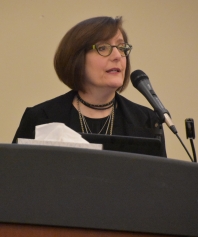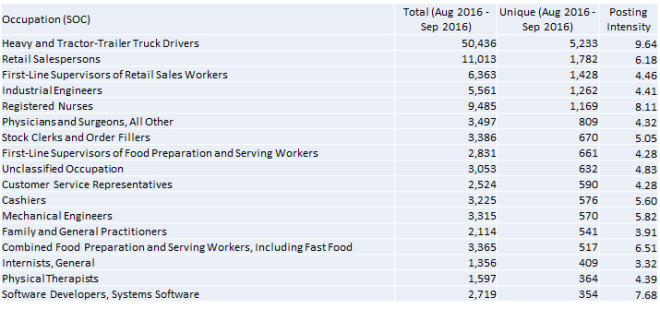It is estimated that 65 percent of today’s kindergarteners will have job titles that do not currently exist. Many of these new roles will be related to STEM, so it is imperative that young people have opportunities to explore and become educated in these fields.
FIRST (For Inspiration and Recognition of Science and Technology) Robotics is a program that does just that. Its mission is to inspire young people to become science and technology leaders by engaging them in mentor-based programs and competitions. These events challenge students to raise funds, design a brand, hone teamwork skills and build and program industrial-size robots that play difficult field games against like-minded  competitors. According to FIRST, this is as close to real-world engineering as a student can get.
competitors. According to FIRST, this is as close to real-world engineering as a student can get.
To learn more about this innovative program, the Macomb Business blog sat down with Gail Alpert, president of FIRST in Michigan, for a Q and A.
Q1: Business and government leaders here in Michigan are very much invested in workforce development and building the next generation of talent. FIRST Robotics and FIRST programming can be an important part of that process. Why is that the case?
A: FIRST is designed to entice high schools students to choose a career in engineering, technology and the skilled trades through the building of a robot with the help of industry mentors from sponsoring companies. Students have the chance to see the tremendous capabilities of their mentors and follow in their footsteps, while the mentors can hand pick the students that best fit their companies for internships and jobs early on, long before the students are recruited by other companies.
Q2: In addition to STEM skills, many FIRST Robotics students develop confidence and communication abilities. How does FIRST programming help young people in this capacity and why should that matter to businesses?
A: There is no better tool in the student’s tool box than learning how to communicate in an effective, concise way. You can have the best product in the world, but if you cannot articulate why it’s the best, or why it’s needed, it means nothing. FIRST students not only compete with their robots, but are interviewed by a group of Judges about their robot and their team as part of the competition. They are extremely well spoken and confident after participating in FIRST.
Q3: With these sentiments in mind, why should businesses get involved with FIRST Robotics and how can they do so? And to clarify, can businesses without a STEM-focus help as well?
A: All types of companies are and can be involved in FIRST, because all companies can play a vital role on a FIRST team even if they don’t have a STEM focus. Each team functions like a small business taking a product from inception to market. Aside from designing, building and fabricating the robot, the teams have to do marketing, fundraising, budgeting and outreach. All companies have some type of expertise that teams can use. Additionally, companies use FIRST to identify leaders and develop leadership skills among their current workforce.
Getting involved is easy. Simply contact me at Gail.Alpert@gmail.com. The busy season for high school teams is January through April. The season ends with the World Competition at Cobo Center on April 25-27 with about 40,000 people in attendance.

Q4: Can you share any anecdotes from businesses that got involved with FIRST Robotics? Did they have positive experiences?
A: FIRST is always a win-win for companies that get involved. Two great examples come to mind. The first was a student that was hired as an intern at a tier one automotive supplier in his junior year. The very first day on the job, the student was given a software program that was relatively new to the company. His mentor told him to play around it with it. After lunch, the mentor returned and asked him how he was coming. The FIRST student replied: “Take a look. I created a game out of it.” The mentor was stunned.
The second story is about a student that planned to go into business rather than engineering. He interned during his freshman year of college at the company that sponsored his high school robotics team. About 20 of us were there for a meeting. The intern was running the meeting and was absolutely phenomenal.
Q5: What’s next for FIRST in Michigan? Are there any new initiatives, partnerships or expansions in the pipeline?
A: We always have new initiatives on the horizon. This year, the state money available through the Marshall Plan is creating fantastic opportunities for collaboration between FIRST teams and companies as communities come up with inventive ways to grow the STEM workforce. At least two of the proposals that were chosen for Plan funding included partnerships with FIRST.
FIRST is also focused on expanding our programs all the way down to kindergarten. In fact, 78 school districts across Michigan currently run all 4 of our programs (high school, middle school, upper and lower elementary school.) This season we are piloting a Pre-K program as well. It’s never too early to foster interest in STEM!
Detroit has been a huge focus for several years as we work to give every student in the city the opportunity to participate. Nearly every high school in Detroit has a FIRST team already, so we created a partnership with the Detroit Police Athletic League and Quicken Loans to start new teams at the middle school and elementary level. Ford, the FCA Foundation, the GM Foundation and Google are helping too. We are working with the Detroit Public Schools Community District to put FIRST in all third grade classrooms.
Finally, the state grant for FIRST, created about 5 years ago, enabled us to expand FIRST to the smallest of school districts in the most remote areas of the state. We are working to make sure the new legislature understands just how critical this funding is to all of our teams and to the continued development of the STEM workforce.
Megan Ochmanek is a communications specialist for the Macomb County Department of Planning and Economic Development.





 Nick Posavetz is an economic development specialist for the Macomb County Department of Planning & Economic Development and is focused on growing, retaining and attracting businesses to Macomb County. To learn about what resources are available for your business, reach out to him at
Nick Posavetz is an economic development specialist for the Macomb County Department of Planning & Economic Development and is focused on growing, retaining and attracting businesses to Macomb County. To learn about what resources are available for your business, reach out to him at 

 Nick Posavetz is a senior planner for Macomb County, often providing content for the Macomb Business and Make Macomb Your Home websites and associated social media accounts. If you have something you’d like to feature, reach out to him at posavetz@macombgov.org.
Nick Posavetz is a senior planner for Macomb County, often providing content for the Macomb Business and Make Macomb Your Home websites and associated social media accounts. If you have something you’d like to feature, reach out to him at posavetz@macombgov.org.


 Nick Posavetz is a senior planner for Macomb County, often providing content for the Macomb Business and Make Macomb Your Home websites and associated social media accounts. If you have something you’d like to feature, reach out to him at posavetz@macombgov.org.
Nick Posavetz is a senior planner for Macomb County, often providing content for the Macomb Business and Make Macomb Your Home websites and associated social media accounts. If you have something you’d like to feature, reach out to him at posavetz@macombgov.org. Nick Posavetz is a senior planner for Macomb County, often providing content for the Macomb Business and Make Macomb Your Home websites and associated social media accounts. If you have something you’d like to feature, reach out to him at posavetz@macombgov.org.
Nick Posavetz is a senior planner for Macomb County, often providing content for the Macomb Business and Make Macomb Your Home websites and associated social media accounts. If you have something you’d like to feature, reach out to him at posavetz@macombgov.org. Nick Posavetz is a senior planner for Macomb County, often providing content for the Macomb Business and Make Macomb Your Home websites and associated social media accounts. If you have something you’d like to feature, reach out to him at posavetz@macombgov.org.
Nick Posavetz is a senior planner for Macomb County, often providing content for the Macomb Business and Make Macomb Your Home websites and associated social media accounts. If you have something you’d like to feature, reach out to him at posavetz@macombgov.org.